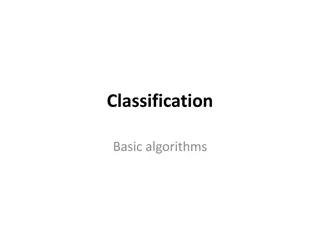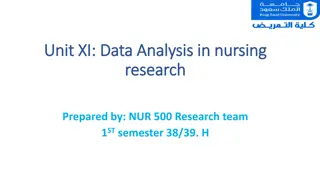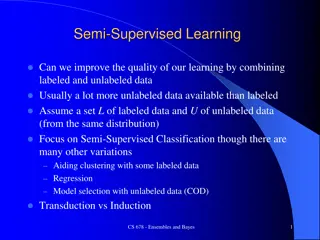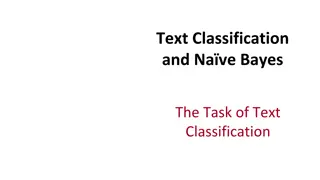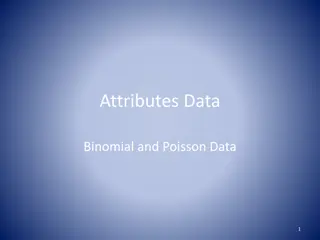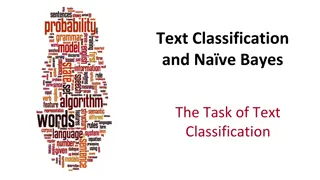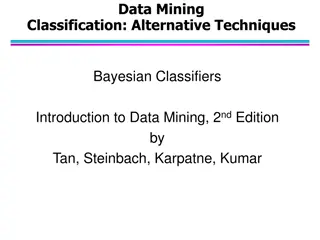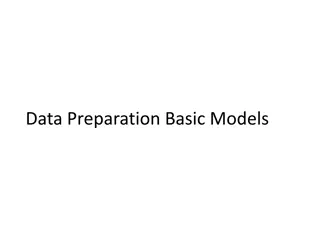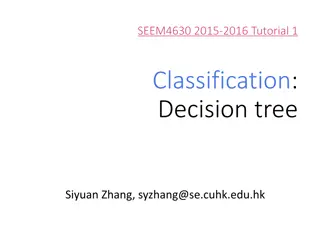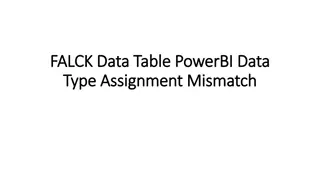Understanding Classification in Data Analysis
Classification is a key form of data analysis that involves building models to categorize data into specific classes. This process, which includes learning and prediction steps, is crucial for tasks like fraud detection, marketing, and medical diagnosis. Classification helps in making informed decisions based on patterns identified in the data. Various algorithms and techniques have been developed for classification across different domains.
Download Presentation

Please find below an Image/Link to download the presentation.
The content on the website is provided AS IS for your information and personal use only. It may not be sold, licensed, or shared on other websites without obtaining consent from the author. Download presentation by click this link. If you encounter any issues during the download, it is possible that the publisher has removed the file from their server.
E N D
Presentation Transcript
Classification Shailaja K.P
Introduction Classification is a form of data analysis that extracts models describing important data classes. Such models, called classifiers, predict categorical (discrete, unordered) class labels. For example, we can build a classification model to categorize bank loan applications as either safe or risky. Such analysis can help provide us with a better understanding of the data at large. Many classification methods have been proposed by researchers in machine learning, pattern recognition, and statistics. Classification has numerous applications, including fraud detection, target marketing, performance prediction, manufacturing, and medical diagnosis.
What Is Classification? A bank loans officer needs analysis of her data to learn which loan applicants are safe and which are risky for the bank. A marketing manager at AllElectronics needs data analysis to help guess whether a customer with a given profile will buy a new computer. In each of these examples, the data analysis task is classification, where a model or classifier is constructed to predict class (categorical) labels, such as safe or risky for the loan application data; yes or no for the marketing data. Suppose that the marketing manager wants to predict how much a given customer will spend during a sale at AllElectronics. This data analysis task is an example of numeric prediction, where the model constructed predicts a continuous-valued function, or ordered value, as opposed to a class label. This model is a predictor. Regression analysis is a statistical methodology that is most often used for numeric prediction. Classification and numeric prediction are the two major types of prediction problems.
General Approach to Classification How does classification work? Data classification is a two-step process, consisting of a learning step (where a classification model is constructed) and a classification step (where the model is used to predict class labels for given data). The process is shown for the loan application data of Figure below.
In the first step, a classifier is built describing a predetermined set of data classes or concepts. This is the learning step (or training phase), where a classification algorithm builds the classifier by analyzing or learning from a training set made up of database tuples and their associated class labels. A tuple, X, is represented by an n-dimensional attribute vector, X = (x1, x2,..., xn), depicting n measurements made on the tuple from n database attributes, A1, A2,..., An. Each tuple, X, is assumed to belong to a predefined class as determined by another database attribute called the class label attribute. The class label attribute is discrete-valued and unordered. It is categorical in that each value serves as a category or class. The individual tuples making up the training set are referred to as training tuples and are randomly sampled from the database under analysis.
Because the class label of each training tuple is provided, this step is also known as supervised learning. This first step of the classification process can also be viewed as the learning of a function, y = f (X), that can predict the associated class label y of a given tuple X. In this view, we wish to learn a function that separates the data classes. Typically, this mapping is represented in the form of classification rules, decision trees, or mathematical formulae. In our example, the mapping is represented as classification rules that identify loan applications as being either safe or risky (Figure a). The rules can be used to categorize future data tuples, as well as provide deeper insight into the data contents.
What about classification accuracy? In the second step (Figure b), the model is used for classification. First, the predictive accuracy of the classifier is estimated. If we were to use the training set to measure the classifier s accuracy, this estimate would likely be optimistic, because the classifier tends to overfit the data . Therefore, a test set is used, made up of test tuples and their associated class labels. They are independent of the training tuples, meaning that they were not used to construct the classifier.
The accuracy of a classifier on a given test set is the percentage of test set tuples that are correctly classified by the classifier. The associated class label of each test tuple is compared with the learned classifier s class prediction for that tuple. If the accuracy of the classifier is considered acceptable, the classifier can be used to classify future data tuples for which the class label is not known. For example, the classification rules learned in Figure (a) from the analysis of data from previous loan applications can be used to approve or reject new or future loan applicants.
Decision Tree Induction Decision tree induction is the learning of decision trees from class-labeled training tuples. A decision tree is a flowchart-like tree structure, where each internal node (nonleaf node) denotes a test on an attribute, each branch represents an outcome of the test, and each leaf node (or terminal node) holds a class label. The topmost node in a tree is the root node. A typical decision tree is shown in Figure below.
It represents the concept buys computer, that is, it predicts whether a customer at AllElectronics is likely to purchase a computer. Internal nodes are denoted by rectangles, and leaf nodes are denoted by ovals. Some decision tree algorithms produce only binary trees (where each internal node branches to exactly two other nodes), whereas others can produce nonbinary trees. How are decision trees used for classification? Given a tuple, X, for which the associated class label is unknown, the attribute values of the tuple are tested against the decision tree. A path is traced from the root to a leaf node, which holds the class prediction for that tuple. Decision trees can easily be converted to classification rules.
Why are decision tree classifiers so popular? The construction of decision tree classifiers does not require any domain knowledge or parameter setting, and therefore is appropriate for exploratory knowledge discovery. Decision trees can handle multidimensional data. The learning and classification steps of decision tree induction are simple and fast. In general, decision tree classifiers have good accuracy. However, successful use may depend on the data at hand. Decision tree induction algorithms have been used for classification in many application areas such as medicine, manufacturing and production, financial analysis, astronomy, and molecular biology.
Decision Tree Induction During the late 1970s and early 1980s, J. Ross Quinlan, a researcher in machine learning, developed a decision tree algorithm known as ID3 (Iterative Dichotomiser). This work expanded on earlier work on concept learning systems, described by E. B. Hunt, J. Marin, and P. T. Stone. Quinlan later presented C4.5 (a successor of ID3), which became a benchmark to which newer supervised learning algorithms are often compared. In 1984, a group of statisticians (L. Breiman, J. Friedman, R. Olshen, and C. Stone) published the book Classification and Regression Trees (CART), which described the generation of binary decision trees. ID3 and CART were invented independently of one another at around the same time, yet follow a similar approach for learning decision trees from training tuples.
ID3, C4.5, and CART adopt a greedy approach in which decision trees are constructed in a top-down recursive divide-and-conquer manner. Most algorithms for decision tree induction follow a top-down approach, which starts with a training set of tuples and their associated class labels. The training set is recursively partitioned into smaller subsets as the tree is being built.
A basic decision tree algorithm is summarized in Figure below.
The strategy is as follows. 1. The algorithm is called with three parameters: D(data partition), attribute list, and Attribute selection method. Initially, D, is the complete set of training tuples and their associated class labels. The parameter attribute list is a list of attributes describing the tuples. Attribute selection method specifies a heuristic procedure for selecting the attribute that best discriminates the given tuples according to class. This procedure employs an attribute selection measure such as information gain or the Gini index. Whether the tree is strictly binary is generally driven by the attribute selection measure. Some attribute selection measures, such as the Gini index, enforce the resulting tree to be binary. Others, like information gain, do not, therein allowing multiway splits (i.e., two or more branches to be grown from a node).
2. The tree starts as a single node, N, representing the training tuples in D (step 1) 3. If the tuples in D are all of the same class, then node N becomes a leaf and is labeled with that class (steps 2 and 3). 4. Otherwise, the algorithm calls Attribute selection method to determine the splitting criterion. The splitting criterion tells us which attribute to test at node N by determining the best way to separate or partition the tuples in D into individual classes (step 6). The splitting criterion also tells us which branches to grow from node N with respect to the outcomes of the chosen test. The splitting criterion is determined so that, ideally, the resulting partitions at each branch are as pure as possible. A partition is pure if all the tuples in it belong to the same class.
5. The node N is labeled with the splitting criterion, which serves as a test at the node (step 7). A branch is grown from node N for each of the outcomes of the splitting criterion. The tuples in D are partitioned accordingly (steps 10 to 11). There are three possible scenarios, as illustrated in Figure below.
Let A be the splitting attribute. A has v distinct values, {a1, a2,..., av }, based on the training data. 1. A is discrete-valued: In this case, the outcomes of the test at node N correspond directly to the known values of A. A branch is created for each known value, aj , of A and labeled with that value (Figure a). Partition Dj is the subset of class-labeled tuples in D having value aj of A. (steps 8 and 9). 2. A is continuous-valued: In this case, the test at node N has two possible outcomes, corresponding to the conditions A split point and A > split point, respectively, where split point is the split-point returned by Attribute selection method as part of the splitting criterion. Two branches are grown from N and labeled according to the previous outcomes (Figure b). The tuples are partitioned such that D1 holds the subset of class- labeled tuples in D for which A split point, while D2 holds the rest.
3. A is discrete-valued and a binary tree must be produced : The test at node N is of the form A SA?, where SAis the splitting subset for A, returned by Attribute selection method as part of the splitting criterion. It is a subset of the known values of A. If a given tuple has value aj of A and if aj SA, then the test at node N is satisfied. Two branches are grown from N (Figure c). By convention, the left branch out of N is labeled yes so that D1 corresponds to the subset of class-labeled tuples in D that satisfy the test. The right branch out of N is labeled no so that D2 corresponds to the subset of class-labeled tuples from D that do not satisfy the test.
The algorithm uses the same process recursively to form a decision tree for the tuples at each resulting partition, Dj , of D (step 14). The recursive partitioning stops only when any one of the following terminating conditions is true: 1. All the tuples in partition D (represented at node N) belong to the same class (steps 2 and 3). 2. There are no remaining attributes on which the tuples may be further partitioned (step 4). In this case, majority voting is employed (step 5). This involves converting node N into a leaf and labeling it with the most common class in D. Alternatively, the class distribution of the node tuples may be stored. 3. There are no tuples for a given branch, that is, a partition Dj is empty (step 12). In this case, a leaf is created with the majority class in D (step 13). The resulting decision tree is returned (step 15).
Attribute Selection Measures An attribute selection measure is a heuristic for selecting the splitting criterion that best separates a given data partition, D, of class-labeled training tuples into individual classes. If we were to split D into smaller partitions according to the outcomes of the splitting criterion, ideally each partition would be pure (i.e., all the tuples that fall into a given partition would belong to the same class). Attribute selection measures are also known as splitting rules because they determine how the tuples at a given node are to be split. The attribute selection measure provides a ranking for each attribute describing the given training tuples. The attribute having the best score for the measure is chosen as the splitting attribute for the given tuples.
There are three popular attribute selection measuresinformation gain, gain ratio, and Gini index. The notation used herein is as follows. Let D, the data partition, be a training set of class-labeled tuples. Suppose the class label attribute has m distinct values defining m distinct classes, Ci(for i = 1,..., m). Let Ci,Dbe the set of tuples of class Ciin D. Let |D| and |Ci,D| denote the number of tuples in D and Ci,D, respectively
Information Gain ID3 uses information gain as its attribute selection measure. Let node N represent or hold the tuples of partition D. The attribute with the highest information gain is chosen as the splitting attribute for node N. This attribute minimizes the information needed to classify the tuples in the resulting partitions and reflects the least randomness or impurity in these partitions. Such an approach minimizes the expected number of tests needed to classify a given tuple and guarantees that a simple tree is found.
The expected information needed to classify a tuple in D is given by where pi is the nonzero probability that an arbitrary tuple in D belongs to class Ciand is estimated by |Ci,D|/|D|. Info(D) is just the average amount of information needed to identify the class label of a tuple in D. How much more information would we still need (after the partitioning) to arrive at an exact classification?
This amount is measured by InfoA(D) is the expected information required to classify a tuple from D based on the partitioning by A. The smaller the expected information (still) required, the greater the purity of the partitions. Information gain is defined as the difference between the original information requirement (i.e., based on just the proportion of classes) and the new requirement (i.e., obtained after partitioning on A). That is, The attribute A with the highest information gain, Gain(A), is chosen as the splitting attribute at node N.
Example 8.1 Induction of a decision tree using information gain. Table below presents a training set, D, of class-labeled tuples randomly selected from the AllElectronics customer database.
The class label attribute, buys computer, has two distinct values (namely, {yes, no}); therefore, there are two distinct classes (i.e., m = 2). Let class C1 correspond to yes and class C2 correspond to no. There are nine tuples of class yes and five tuples of class no. A (root) node N is created for the tuples in D. To find the splitting criterion for these tuples, we must compute the information gain of each attribute. We first use Eq. (8.1) to compute the expected information needed to classify a tuple in D:
Next, we need to compute the expected information requirement for each attribute. Let s start with the attribute age. We need to look at the distribution of yes and no tuples for each category of age. For the age category youth, there are two yes tuples and three no tuples. For the category middle aged, there are four yes tuples and zero no tuples. For the category senior, there are three yes tuples and two no tuples. Using Eq. (8.2), the expected information needed to classify a tuple in D if the tuples are partitioned according to age is
Hence, the gain in information from such a partitioning would be Gain(age) = Info(D) Infoage(D) = 0.940 0.694 = 0.246 bits. Similarly, we can compute Gain(income) = 0.029 bits, Gain(student) = 0.151 bits, and Gain(credit rating) = 0.048 bits. Because age has the highest information gain among the attributes, it is selected as the splitting attribute. Node N is labeled with age, and branches are grown for each of the attribute s values. The tuples are then partitioned accordingly, as shown in Figure below.
Notice that the tuples falling into the partition for age = middle aged all belong to the same class. Because they all belong to class yes, a leaf should therefore be created at the end of this branch and labeled yes. The final decision tree returned by the algorithm was shown earlier in Figure below.
Gain Ratio C4.5, a successor of ID3, uses an extension to information gain known as gain ratio. It applies a kind of normalization to information gain using a split information value defined analogously with Info(D) as This value represents the potential information generated by splitting the training data set, D, into v partitions, corresponding to the v outcomes of a test on attribute A. Note that, for each outcome, it considers the number of tuples having that outcome with respect to the total number of tuples in D.
It differs from information gain, which measures the information with respect to classification that is acquired based on the same partitioning. The gain ratio is defined as The attribute with the maximum gain ratio is selected as the splitting attribute.
Example 8.2 Computation of gain ratio for the attribute income. A test on income splits the data of Table 8.1 into three partitions, namely low, medium, and high, containing four, six, and four tuples, respectively. To compute the gain ratio of income, we first use Eq. (8.5) to obtain From Example 8.1, we have Gain(income) = 0.029. Therefore, GainRatio(income) = 0.029/1.557 = 0.019.
Gini Index The Gini index is used in CART. Using the notation previously described, the Gini index measures the impurity of D, a data partition or set of training tuples, as where pi is the probability that a tuple in D belongs to class Ci and is estimated by |Ci,D|/|D|. The sum is computed over m classes. The Gini index considers a binary split for each attribute.
Lets first consider the case where A is a discrete-valued attribute having v distinct values, {a1, a2,..., av }, occurring in D. To determine the best binary split on A, we examine all the possible subsets that can be formed using known values of A. For example, if income has three possible values, namely {low, medium, high}, then the possible subsets are {low, medium, high}, {low, medium}, {low, high}, {medium, high}, {low}, {medium}, {high}, and {}. We exclude the power set, {low, medium, high}, and the empty set from consideration since, conceptually, they do not represent a split. Therefore, there are 2v 2 possible ways to form two partitions of the data, D, based on a binary split on A.
When considering a binary split, we compute a weighted sum of the impurity of each resulting partition. For example, if a binary split on A partitions D into D1 and D2, the Gini index of D given that partitioning is For each attribute, each of the possible binary splits is considered. For a discrete-valued attribute, the subset that gives the minimum Gini index for that attribute is selected as its splitting subset. For continuous-valued attributes, each possible split-point must be considered.
The reduction in impurity that would be incurred by a binary split on a discrete- or continuous-valued attribute A is The attribute that maximizes the reduction in impurity (or, equivalently, has the minimum Gini index is selected as the splitting attribute. This attribute and either its splitting subset (for a discrete-valued splitting attribute) or split-point (for a continuous-valued splitting attribute) together form the splitting criterion.
Example 8.3 Induction of a decision tree using the Gini index. Let D be the training data shown earlier in Table 8.1, where there are nine tuples belonging to the class buys computer = yes and the remaining five tuples belong to the class buys computer = no. A (root) node N is created for the tuples in D. We first use Eq. (8.7) for the Gini index to compute the impurity of D: To find the splitting criterion for the tuples in D, we need to compute the Gini index for each attribute. Let s start with the attribute income and consider each of the possible splitting subsets. Consider the subset {low, medium}. This would result in 10 tuples in partition D1 satisfying the condition income {low, medium}. The remaining four tuples of D would be assigned to partition D2.
Similarly, the Gini index values for splits on the remaining subsets are 0.458 (for the subsets {low, high} and {medium}) and 0.450 (for the subsets {medium, high} and {low}). Therefore, the best binary split for attribute income is on {low, medium} (or {high}) because it minimizes the Gini index. Evaluating age, we obtain {youth, senior} (or {middle aged}) as the best split for age with a Gini index of 0.375; the attributes student and credit rating are both binary, with Gini index values of 0.367 and 0.429, respectively. The attribute age and splitting subset {youth, senior} therefore give the minimum Gini index overall, with a reduction in impurity of 0.459 0.357 = 0.102. The binary split age {youth, senior?} results in the maximum reduction in impurity of the tuples in D and is returned as the splitting criterion. Node N is labeled with the criterion, two branches are grown from it, and the tuples are partitioned accordingly.
Tree Pruning When a decision tree is built, many of the branches will reflect anomalies in the training data due to noise or outliers. Tree pruning methods address this problem of overfitting the data. Such methods typically use statistical measures to remove the least-reliable branches. An unpruned tree and a pruned version of it are shown in Figure below. Pruned trees tend to be smaller and less complex and, thus, easier to comprehend. They are usually faster and better at correctly classifying independent test data (i.e., of previously unseen tuples) than unpruned trees. How does tree pruning work? There are two common approaches to tree pruning: prepruning and postpruning
In the prepruning approach, a tree is pruned by halting its construction early. Upon halting, the node becomes a leaf. The leaf may hold the most frequent class among the subset tuples or the probability distribution of those tuples. When constructing a tree, measures such as statistical significance, information gain, Gini index, and so on, can be used to assess the goodness of a split. The second and more common approach is postpruning, which removes subtrees from a fully grown tree. A subtree at a given node is pruned by removing its branches and replacing it with a leaf. The leaf is labeled with the most frequent class among the subtree being replaced.
Bayes Classification Methods What are Bayesian classifiers? Bayesian classifiers are statistical classifiers. They can predict class membership probabilities such as the probability that a given tuple belongs to a particular class. Bayesian classification is based on Bayes theorem. Studies comparing classification algorithms have found a simple Bayesian classifier known as the na ve Bayesian classifier to be comparable in performance with decision tree and selected neural network classifiers. Bayesian classifiers have also exhibited high accuracy and speed when applied to large databases.
Bayes Theorem Bayes theorem is named after Thomas Bayes, who did early work in probability and decision theory during the 18th century. Let X be a data tuple. In Bayesian terms, X is considered evidence. As usual, it is described by measurements made on a set of n attributes. Let H be some hypothesis such as that the data tuple X belongs to a specified class C. For classification problems, we want to determine P(H|X), the probability that the hypothesis H holds given the evidence or observed data tuple X. In other words, we are looking for the probability that tuple X belongs to class C, given that we know the attribute description of X.
P(H|X) is the posterior probability, of H conditioned on X. For example, suppose our world of data tuples is confined to customers described by the attributes age and income, respectively, and that X is a 35-year-old customer with an income of $40,000. Suppose that H is the hypothesis that our customer will buy a computer. Then P(H|X) reflects the probability that customer X will buy a computer given that we know the customer s age and income. In contrast, P(H) is the prior probability, of H. For our example, this is the probability that any given customer will buy a computer, regardless of age, income, or any other information. Similarly, P(X|H) is the posterior probability of X conditioned on H. That is, it is the probability that a customer, X, is 35 years old and earns $40,000, given that we know the customer will buy a computer.
P(X) is the prior probability of X. Using our example, it is the probability that a person from our set of customers is 35 years old and earns $40,000. How are these probabilities estimated? P(H), P(X|H), and P(X) may be estimated from the given data. Bayes theorem is useful in that it provides a way of calculating the posterior probability, P(H|X), from P(H), P(X|H), and P(X). Bayes theorem is P
Nave Bayesian Classification The na ve Bayesian classifier, or simple Bayesian classifier, works as follows: 1. Let D be a training set of tuples and their associated class labels. As usual, each tuple is represented by an n-dimensional attribute vector, X = (x1, x2,..., xn), depicting n measurements made on the tuple from n attributes, respectively, A1, A2,..., An. 2. Suppose that there are m classes, C1, C2,..., Cm. Given a tuple, X, the classifier will predict that X belongs to the class having the highest posterior probability, conditioned on X. That is, the na ve Bayesian classifier predicts that tuple X belongs to the class Ciif and only if Thus, we maximize P(Ci|X). The class Ci for which P(Ci|X) is maximized is called the maximum posteriori hypothesis. By Bayes theorem (Eq. 8.10),
3. As P(X) is constant for all classes, only P(X|Ci)P(Ci) needs to be maximized. If the class prior probabilities are not known, then it is commonly assumed that the classes are equally likely, that is, P(C1) = P(C2) = = P(Cm), and we would therefore maximize P(X|Ci). Otherwise, we maximize P(X|Ci)P(Ci). Note that the class prior probabilities may be estimated by P(Ci) = |Ci,D|/|D|, where |Ci,D| is the number of training tuples of class Ciin D. 4. Given data sets with many attributes, it would be extremely computationally expensive to compute P(X|Ci). To reduce computation in evaluating P(X|Ci), the na ve assumption of class-conditional independence is made. This presumes that the attributes values are conditionally independent of one another, given the class label of the tuple (i.e., that there are no dependence relationships among the attributes). Thus, We can easily estimate the probabilities P(x1|Ci), P(x2|Ci),..., P(xn|Ci) from the training tuples. Recall that here xk refers to the value of attribute Ak for tuple X. For each attribute, we look at whether the attribute is categorical or continuous-valued.















